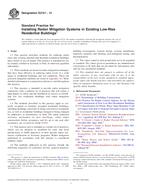Potrebujeme váš súhlas na využitie jednotlivých dát, aby sa vám okrem iného mohli ukazovať informácie týkajúce sa vašich záujmov. Súhlas udelíte kliknutím na tlačidlo „OK“.
ASTM E2121-13
Standard Practice for Installing Radon Mitigation Systems in Existing Low-Rise Residential Buildings
Automaticky preložený názov:
Štandardné praktiky pre inštaláciu Radón zmierňovanie Systems v existujúcich nízkopodlažných bytových domov
NORMA vydaná dňa 1.3.2013
Informácie o norme:
Označenie normy: ASTM E2121-13
Poznámka: NEPLATNÁ
Dátum vydania normy: 1.3.2013
Kód tovaru: NS-44374
Počet strán: 13
Približná hmotnosť: 39 g (0.09 libier)
Krajina: Americká technická norma
Kategória: Technické normy ASTM
Kategórie - podobné normy:
Anotácia textu normy ASTM E2121-13 :
Keywords:
depressurization, radon, radon entry, radon mitigation, radon reduction, ICS Number Code 91.120.99 (Other standards related to protection of and in buildings)
Doplňujúce informácie
| Significance and Use | ||||||
|
5.1 The purpose of the methods, systems, and designs described in this practice is to reduce radiation exposures for occupants of residential buildings caused by radon and its progeny. The goal of mitigation is to maintain reduced radon concentrations in occupiable areas of buildings at levels as low as reasonably achievable. This practice includes sections on reducing radiation exposure caused by radon and its progeny for workers who install and repair radon mitigation systems. The goal for workers is to reduce exposures to radon and its progeny to levels as low as reasonably achievable. 5.2 The methods, systems, designs, and materials described here have been shown to have a high probability of success in mitigating radon in attached and detached residential buildings, three stories or less in height (see EPA, “Radon Reduction Techniques for Existing Detached Houses, Technical Guidance (Third Edition) for Active Soil Depressurization Systems”). Application of these methods does not, however, guarantee reduction of radon levels below any specific level, since performance will vary with site conditions, construction characteristics, weather, and building operation. 5.3 When applying this practice, contractors also shall conform to all applicable local, state, and federal regulations, and laws pertaining to residential building construction, remodeling, and improvement. |
||||||
| 1. Scope | ||||||
|
1.1 This practice describes methods for reducing radon entry into existing attached and detached residential buildings three stories or less in height. This practice is intended for use by trained, certified or licensed, or both, or otherwise qualified individuals. 1.2 These methods are based on radon mitigation techniques that have been effective in reducing radon levels in a wide range of residential buildings and soil conditions. These fan powered mitigation methods are listed in 1.3 This practice is intended to provide radon mitigation contractors with a uniform set of practices that will ensure a high degree of safety and the likelihood of success in retrofitting low rise residential buildings with radon mitigation systems. 1.4 The methods described in this practice apply to currently occupied or formerly occupied residential buildings, including buildings converted or being converted to residential use, as well as residential buildings changed or being changed by addition(s) or alteration(s), or both. The radon reduction activities performed on new dwellings, while under construction, before occupancy, and for up to one year after occupancy, are covered by Guide E1465. 1.5 This practice also is intended as a model set of practices, which can be adopted or modified by state and local jurisdictions, to fulfill objectives of their specific radon contractor certification or licensure programs. Radon mitigation performed in accordance with this practice is considered ordinary repair. 1.6 The methods addressed in this practice include the following categories of contractor activity: general practices, building investigation, systems design, systems installation, materials, monitors and labeling, post-mitigation testing, and documentation. 1.7 The values stated in inch-pound units are to be regarded as standard. The values given in parentheses are mathematical conversions to SI units that are provided for information only and are not considered standard. 1.8 This standard does not
purport to address all of the safety concerns, if any, associated
with its use. It is the responsibility of the user of this standard
to establish appropriate safety and health practices and determine
the applicability of regulatory limitations prior to use.
Standard Specification for Plastic Water
Vapor Retarders Used in Contact with Soil or Granular Fill under
Concrete Slabs Standard Practice for Radon Control
Options for the Design and Construction of New Low-Rise Residential
Buildings Standard Terminology of Building
Constructions |
Odporúčame:
Aktualizácia technických noriem
Chcete mať istotu, že používate len platné technické normy?
Ponúkame Vám riešenie, ktoré Vám zaistí mesačný prehľad o aktuálnosti noriem, ktoré používate.
Chcete vedieť viac informácií ? Pozrite sa na túto stránku.




 Cookies
Cookies
